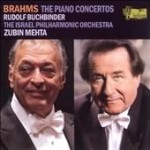In and of themselves Rudolf Buchbinder’s live Brahms concerto collaborations with Zubin Mehta and the Israel Philharmonic stand out for superb execution, stylish power, and fluid soloist/orchestra integration. However, the question remains: how do they compare with Buchbinder’s remarkable versions with Nikolaus Harnoncourt and the Concertgebouw Orchestra, which remain a modern-day point of reference?
You may prefer the new D minor first movement’s more conventionally animated basic tempos; yet the markedly slower Harnoncourt version’s unrelenting intensity yields a higher level of exactitude and detail, such as in Buchbinder’s more scrupulously measured trills and the stronger brass presence. Both versions’ Rondo finales are equally vigorous and supple, but Harnoncourt’s superior ear for detail wins the day (the bassoon counterline underneath the opening piano solo, for instance).
I marginally prefer Mehta’s B-flat concerto finale over Harnoncourt for its warmer string tone and more judicious solo/orchestra balance, plus more direct phrasing on Buchbinder’s part. The pianist also shapes the Andante’s contrapuntal climaxes and declamatory trills more impetuously here than with Harnoncourt, although the latter recording finds Buchbinder exerting less effort over the first movement’s opening cadenza and the second movement’s sotto voce legato octaves.
The sonics are finer than usual for a live, archival recording, despite a high level of audience noise. Along with two well-played Schubert and Beethoven encores, Buchbinder brilliantly serves up one of his unsuspected specialties in the form of Alfred Grünfeld’s frothy and quite difficult Die Fledermaus paraphrase. Those who collect multiple Brahms piano concerto recordings surely will want to investigate this release, but the Buchbinder/Harnoncourt cycle’s superior sonics and formidable interpretive profile remain first priority.
































